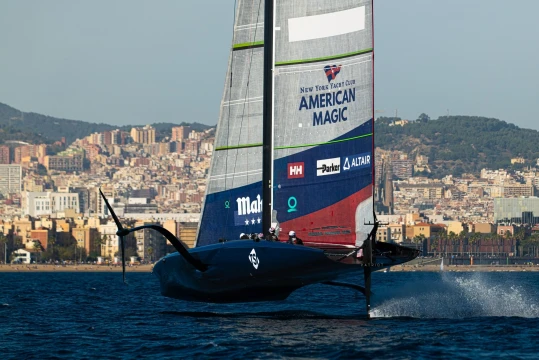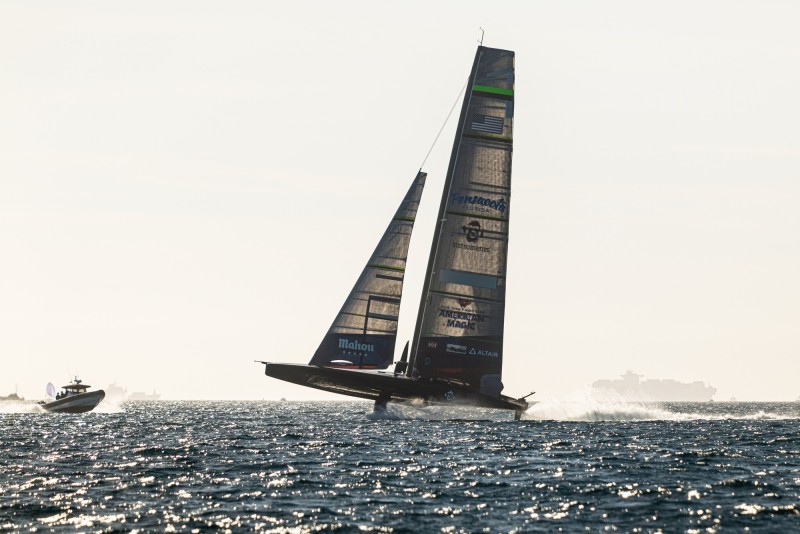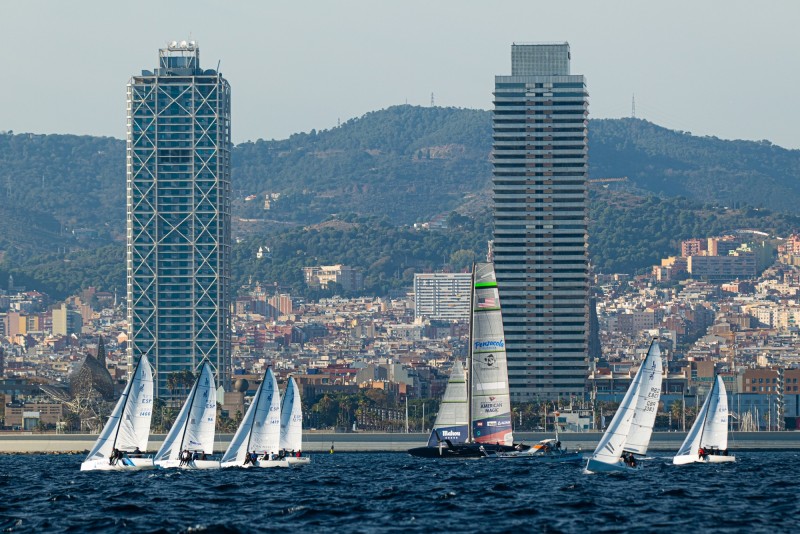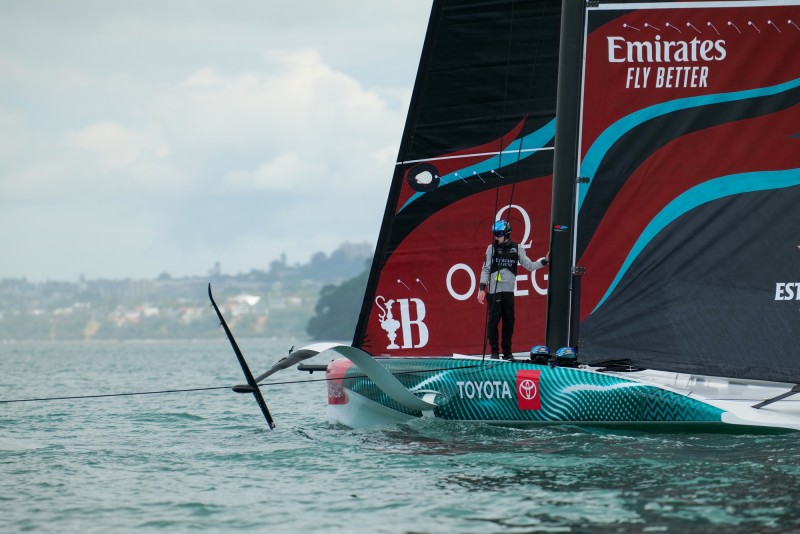
American Magic's Patriot in Barcelona, ETNZ in Auckland
American Magic's Patriot in Barcelona, ETNZ in Auckland
The pace of testing in this critical period ahead of the new AC75s hitting the water in the Spring, picked up again with NYYC American Magic deep into systems and controls evaluation on Saturday whilst Monday afternoon in Auckland saw Emirates Team New Zealand out in, at times, marginal, light conditions to dig into the data of their new bullet-shaped port foil.
The body language around American Magic at the moment is palpably positive with the full team onsite early doors on Saturday morning and everyone mucking in to get ‘Patriot’ launched and ready for another day on the water. With the enlarged team featuring the super-fit cyclors, there’s a buzz around the base and there’s confidence abounding in the programme with a real sense of anticipation at what’s being built up in Portsmouth, Rhode Island. The team has spent almost all summer on a relentless foil analysis programme with the two AC40s but the chance to get the ‘big bus’ back into commission is something that has really focussed the sailors and shore team.
Once docked-out and into a relatively benign 8 knots of breeze it was a case of sailing in displacement and waiting for the build with some interesting techniques on display of backing the jib – something we don’t normally see on the AC75 – to aid the bear-away. However, once Barcelona obliged and a couple more knots filtered in, Patriot was up and running on her made-for-Auckland anhedral foils and whilst pretty stable in flight on a long downwind leg, gybes were a concern with full splashdowns occurring.

As the breeze built to 12-15 knots, the team went down a couple of jib codes but still manoeuvres were an issue with the bow digging in and a sense of frustration creeping in. Paul Goodison and Tom Slingsby were riding big angles on the bear-away mark roundings over the windward/leeward course and their transitions side to side through tacks looked to be compensating for systems gremlins at times as the team re-commission a much-adapted ‘Patriot’ back up to race pace. No doubt they will get there but the gybe ratio foil-to-foil of 48% will see the coaches and analysts earning their fee.
One area that American Magic certainly seems to be nailing with the help of cycling equipment manufacturer SRAM is the power output from the cyclors and it’s this area that is getting a lot of attention to minimise wasted watts. It’s a tough gig being a cyclor in the 37th America’s Cup but one person that epitomises the current generation of cyclors is John Croom who transferred from Olympic Track Cycling to the Cup and is enjoying the team spirit and camaraderie. Asked about the switch from a solo sport to a team sport, John said: “It actually was kind of something refreshing. It wasn't hard at all, something that I actually missed. I was a heavyweight wrestler and football player back in school before cycling and that was big time team sports and sort of like get back into this for it to be one big team all the way down through the staff has been something really, really, special and the support’s unreal.”
And for this cyclist who had never before stepped on a boat, John gave a glimpse into what life is like on the AC75 saying: “I think 30 knots feels normal to me in a sailboat. I mean the first time I ever sailed was in an AC75, like 'ever' sailing, and so first time is always the most exciting obviously with the G-forces in the manoeuvres etc with your gut almost dropping out every time but yeah something really special.” Talking about the tech and the development work going on around the cyclor system, John added: “We're working with SRAM and SRAM’s been super helpful in getting all of our equipment but yeah, it's just like any other thing, it's like riding a bike.

One very nice aside on Saturday was the American Magic Chase Boat team coming to the assistance of a cruising boat that had been de-masted just off the La Barceloneta beachfront with several team members jumping onboard to help the stricken sailor. Top work by the team.
Out in Auckland it was a busy Monday for Emirates Team New Zealand who put in a two-and-a-half-hour session in a variable breeze that at times was sub 8 knots before building to gusts of 16 knots. The on-water recon team made a very good observation about sailing style saying: “First hour of sailing included very low exits out of tacks and high exits out of gybes and a lot of traveller play. As the breeze built, a lot more mainsheet tension and twist were played with very little traveller use. Good, synchronized sail trim out of manoeuvres especially in the light. The team have learnt to tack onto the new foil much better in the marginal conditions today compared to two weeks ago.”
Once again the results of the day showed a 91% foil-to-foil ratio across both tacks and gybes which was remarkable considering the conditions and what we suspect were some control issues again with the port foil that caused a technician to come onboard to look at the problem mid-session. Once fixed, the sailors put on a terrific performance of high-technique and even higher communications co-ordination with some beautiful 360 degree manoeuvres and some very smart downwind gybes with the over-sheeted main traveller and a visibly tighter mainsheet setting that caused considerable creasing down to the clew. Onboard today, the team fitted a LIDAR camera on the starboard side on a big arm to accurately measure volumetric depth and in the sky the Chase Boat team were running a drone looking specifically at the leeward skin of the mainsail upwind and the new port foil’s wing wash.
Valuable day in flat water for Emirates Team New Zealand who are now starting to eye the upcoming America’s Cup Preliminary Regatta, presented by NEOM, at the end of the month. Andy Maloney spoke to the recon team after sailing and confirmed the schedule ahead, saying: “It's really just finishing up this foil testing block before we start looking forward to Jeddah and preparing as best we can for that one-design regatta coming up - quite a different style of sailing for us on the boat, you know we all do different roles, so try and transition into that as quickly as we can over this week.”

And the goal for Jeddah is clear with Andy adding: “Obviously to win the event, you know we were disappointed last time to not quite come away with the win, not to get to do that final match race, so there's a lot of motivation for us as a team to get there get back into the one-design boat, get dialled in as quickly as we can and then try and put our best foot forward in racing.”
Looking back at this block of foil testing, Andy offered: “All the foils are different, we've got Blair (Tuke) and myself controlling them, but we've got another thirty people who are very experienced in looking at foils so it's great to have everyone looking at them from different angles and learning as much as we can about them and the difference between the two going forward.”
The team were off the water and docked-in by 2.30pm and have another couple of days of testing in Auckland this week before attention turns to Jeddah, Saudi Arabia and the America’s Cup Preliminary Regatta, presented by NEOM, that starts on the 30th November. (Magnus Wheatley)
On-Water Recon Report – Emirates Team New Zealand: Day 45 for Emirates Team New Zealand in the LEQ 12 had a mix of conditions allowing testing in a range of breezes. The day started with a 12:00 dock out and sail hoist straight out in front of the base before a tow down the harbour in search of breeze. Sails choice was the M2 and J2 for the entire session.
Breeze was found in the Rangitoto Channel, and the team dropped the tow on the foils and commenced testing. They sailed a few laps up and down in a small area of water where there was breeze, completing almost all manoeuvres on the foil. Wind speed in the zone was not much more than 8 knots. When a non-foiling manoeuvre occurred, a tow was required to get back on the foils as there was not enough breeze generally to self-take-off.
Eventually at 12:52 the breeze shut down in this area and the team decided to take a break as they could no longer stay on the foil. It was looking a little dire on the Gulf however. Luckily for the team, a few easterly cells made their way across from the Back Paddock and the team were able to get up and foiling again. Some of these systems bought as much as 16-17 knots of breeze but the average was around 12-14 knots.
The team set up training to the South of Rangitoto sailing upwind/downwind laps between two yellow marker boys. The flat water gave the team a perfect sailing area and the wind, although up and down at times, was made the most of by the team. They sailed some longer tacks testing, and towards the end, were starting to increase the manoeuvres and were seen doing multiple full foiling 360’s including two foil glide entries and also well-timed foil arm up/downs through tack to gybe and gybe to tack circles. Overpowered at times being up range with the J2, they were running quite twisty sail profiles today. Sail trim across jib and main as in the last few sessions was very synchronised. As the breeze came up, a lot of sail ease could be seen out of tacks and more twist, with not a load of traveller being played. The yacht and sailors seemed to be performing well.
At 14:06, the team bore away off St Heliers and finally headed for home after an eventful day of weather and sailing out on the gulf. On the way back up the harbour, they continued to practice many gybes and even a few aggressive circles all the way up to Stanley Point. They were really trying to push them around. One or two were semi successful with a touch and go, and the third eventuated in a full touch down. They displacement sailed back towards the chase boat before rounding up and commencing sails down at 14:20.
The team arrived back at the dock at 14:40 and we were able to get in a chat with Flight Controller, Andy Maloney, who seemed pretty happy with what they had gotten out of the day on the water.
On-Water Recon Report – NYYC American Magic: American Magic rounded off the week with a solid day of sailing aboard their previous-generation AC75 Patriot clocking up four hours on the water in winds ranging from 6 to 15 knots. The session appeared to be free of technical issues with the boat up and foiling for the vast majority of the time – although there were plenty of splashdowns, both during tacks and gybes as well as roundups. Patriot emerged from the American Magic hangar at 0845 and by 0932 was rigged and in the water ready for dock-out at 1058.
After leaving the harbour at 1108 the boat was bow-towed to the north-east for 20 minutes at speeds up to 30 knots before stopping for sails – MN7 mainsail and J1.5-2 headsail – to be hoisted by 1145. The breeze was less than 8 knots (from 200) at this point with a flat sea.
Patriot sailed on port in displacement mode for several minutes with a crew member moving around the boat taking sail and mast pictures and checking in between the mainsails skins at the clew area. It was notable that the crew had to manually back the headsail with a sailor on the bow to get the boat to bear away from a standing start and after a displacement tack.
As the breeze started to ramp up towards 10 knots Patriot easily took flight on starboard tack and sailed for a minute or so with more sail and mast pictures being taken before bearing away into a fast downwind run to begin a series of windward/leeward laps. The boat did not appear comfortable during gybes with the majority being full touch down.
A stop at 1220 saw a change to the J2-5 with the boat back in the air by 1230 for a downwind run that began an extended period of windward / leeward course sailing around two pairs of buoys. With the breeze increasing steadily over the afternoon the crew stopped again at 1535 to change down to a J3 headsail. Unfortunately, we could not identify if it was the J3-4 or J3-6 - which had both been loaded aboard the chase boat in the morning.
During the multiple laps sailed around the course Patriot looked stable and fast in a straight line both upwind and downwind, but the crew still appeared to be having issues through some tacks and gybes and on mark roundings – which often had very wide exits. Additionally, a couple of times there appeared to be a loss of control during turn ups from downwind to upwind ending with a steep bow up surge and a splashdown.
After a long final upwind time was called at 1530 with sails down by 1540 and the boat back on the dock by 1553. No sailing is planned for tomorrow (Sunday November 19).





